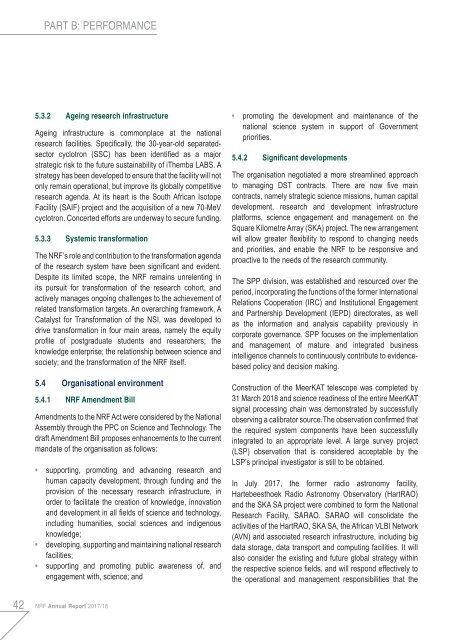NRF Annual Report 2018
You also want an ePaper? Increase the reach of your titles
YUMPU automatically turns print PDFs into web optimized ePapers that Google loves.
PART B: PERFORMANCE<br />
5.3.2 Ageing research infrastructure<br />
Ageing infrastructure is commonplace at the national<br />
research facilities. Specifically, the 30-year-old separatedsector<br />
cyclotron (SSC) has been identified as a major<br />
strategic risk to the future sustainability of iThemba LABS. A<br />
strategy has been developed to ensure that the facility will not<br />
only remain operational, but improve its globally competitive<br />
research agenda. At its heart is the South African Isotope<br />
Facility (SAIF) project and the acquisition of a new 70-MeV<br />
cyclotron. Concerted efforts are underway to secure funding.<br />
5.3.3 Systemic transformation<br />
The <strong>NRF</strong>’s role and contribution to the transformation agenda<br />
of the research system have been significant and evident.<br />
Despite its limited scope, the <strong>NRF</strong> remains unrelenting in<br />
its pursuit for transformation of the research cohort, and<br />
actively manages ongoing challenges to the achievement of<br />
related transformation targets. An overarching framework, A<br />
Catalyst for Transformation of the NSI, was developed to<br />
drive transformation in four main areas, namely the equity<br />
profile of postgraduate students and researchers; the<br />
knowledge enterprise; the relationship between science and<br />
society; and the transformation of the <strong>NRF</strong> itself.<br />
5.4 Organisational environment<br />
5.4.1 <strong>NRF</strong> Amendment Bill<br />
Amendments to the <strong>NRF</strong> Act were considered by the National<br />
Assembly through the PPC on Science and Technology. The<br />
draft Amendment Bill proposes enhancements to the current<br />
mandate of the organisation as follows:<br />
• supporting, promoting and advancing research and<br />
human capacity development, through funding and the<br />
provision of the necessary research infrastructure, in<br />
order to facilitate the creation of knowledge, innovation<br />
and development in all fields of science and technology,<br />
including humanities, social sciences and indigenous<br />
knowledge;<br />
• developing, supporting and maintaining national research<br />
facilities;<br />
• supporting and promoting public awareness of, and<br />
engagement with, science; and<br />
• promoting the development and maintenance of the<br />
national science system in support of Government<br />
priorities.<br />
5.4.2 Significant developments<br />
The organisation negotiated a more streamlined approach<br />
to managing DST contracts. There are now five main<br />
contracts, namely strategic science missions, human capital<br />
development, research and development infrastructure<br />
platforms, science engagement and management on the<br />
Square Kilometre Array (SKA) project. The new arrangement<br />
will allow greater flexibility to respond to changing needs<br />
and priorities, and enable the <strong>NRF</strong> to be responsive and<br />
proactive to the needs of the research community.<br />
The SPP division, was established and resourced over the<br />
period, incorporating the functions of the former International<br />
Relations Cooperation (IRC) and Institutional Engagement<br />
and Partnership Development (IEPD) directorates, as well<br />
as the information and analysis capability previously in<br />
corporate governance. SPP focuses on the implementation<br />
and management of mature and integrated business<br />
intelligence channels to continuously contribute to evidencebased<br />
policy and decision making.<br />
Construction of the MeerKAT telescope was completed by<br />
31 March <strong>2018</strong> and science readiness of the entire MeerKAT<br />
signal processing chain was demonstrated by successfully<br />
observing a calibrator source.The observation confirmed that<br />
the required system components have been successfully<br />
integrated to an appropriate level. A large survey project<br />
(LSP) observation that is considered acceptable by the<br />
LSP’s principal investigator is still to be obtained.<br />
In July 2017, the former radio astronomy facility,<br />
Hartebeesthoek Radio Astronomy Observatory (HartRAO)<br />
and the SKA SA project were combined to form the National<br />
Research Facility, SARAO. SARAO will consolidate the<br />
activities of the HartRAO, SKA SA, the African VLBI Network<br />
(AVN) and associated research infrastructure, including big<br />
data storage, data transport and computing facilities. It will<br />
also consider the existing and future global strategy within<br />
the respective science fields, and will respond effectively to<br />
the operational and management responsibilities that the<br />
42<br />
<strong>NRF</strong> <strong>Annual</strong> <strong>Report</strong> 2017/18


